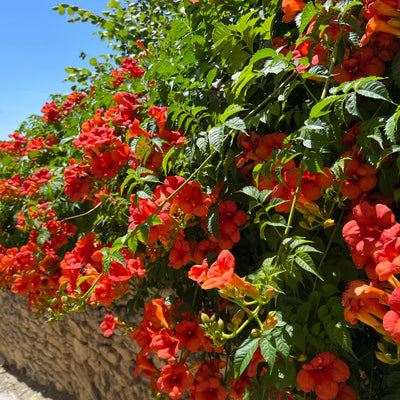Transform Your Lawn into a Wildflower Haven
5 Benefits Of Converting Lawns Into Wildflower Landscapes
Imagine squandering money on something that requires you to work longer hours, using machinery that emits carbon emissions, eliminating wildlife habitats, and introducing harsh chemicals into the soil and groundwater. If you think there should be a law against this practice, there's not. It may be a tough pill to swallow, but those rank among the negative impacts of a well-manicured lawn.
But the good news is that homeowners no longer need to "keep up with the Joneses," as the saying goes. By employing some outside-the-box thinking, you can be a landscaping trendsetter while feeling good about pivoting away from the negatives surrounding lawns' treatment, care, and existence. Converting a section of your property to a wildflower meadow eliminates those negatives and replaces them with the following benefits.
No More Weekend Mowing & Edging
It's not unusual to drive past rows upon rows of green lawns and want to emulate them. Suburban landscapes are primarily designed to include a front yard, not a more natural habitat. New construction builds and existing single-family homes almost always seem to have lawns that require DIY work or hiring a professional.
The average property owner typically spends a soul-crushing 70 hours yearly on lawn maintenance. To put that in context, many Americans enjoy a two-week vacation, which tallies only about 80 work hours. You spend almost as much time working on the lawn during off-hours as you reap in an annual vacation. Eliminating lawn work adds a tremendous quality of life benefit.

Feel Good About Protecting The Environment
It may come as a surprise, but the lower 48 states include over 50 million acres of lawn. Adding insult to injury, turf farms have replaced food growing in some areas because homeowners inadvertently made grass more profitable than vegetables.
Imagine that Americans now expend more water on manicured lawns than growing corn. Not only has suburban sprawl destroyed forests, but lawns are now the highest irrigated crop. Studies indicate that two-thirds of residential water use occurs outdoors. Clean water has become increasingly scarce, and front yard grass ranks among the least drought-resistant landscaping elements.
Good people want to do their part to protect our natural resources, and water remains a top priority. Pivoting away from passive grass to a drought-resistant wildflower meadow means you can take pride in knowing you're not wasting water.
Restore Crucial Resource For Declining Bee Populations
Bees remain a cornerstone of a healthy environment because they help cross-pollinate everything from tomato plants to fruit trees. Without a flourishing bee population, necessary food harvests are jeopardized, and lawns contribute to their loss.
The U.S. Department of Agriculture said vital pollinators stood at a "crossroads" in 2019. A National Geographic report pegged the decline in Western bee populations over the last 15 years at 90 percent. While lawns and suburban sprawl are only partially to blame, property owners can help turn the tide.
Flowering perennial plants in wildflower meadows rank among the primary food resources for bees and other pollinators such as butterflies and hummingbirds. Replacing an expensive lawn that sometimes requires toxic chemical treatments with colorful blooms and sweeping greenery provides the food necessary for a robust bee population. Fruit trees, vegetable gardens, berry bushes, and farming crops produce higher yields when successfully pollinated by bees.
Give Children First-Hand Wildlife Education
Homeowners attract more than honeybees and butterflies by converting lawn space into a wildflower oasis. The tall flowering perennials create a haven for harmless ground bugs such as beetles that birds feed on. What began as an eye-catching sea of flowers evolved into a lush habitat for birds such as warblers, finches, owls, robins, and breathtaking hummingbirds. Don't be surprised if a family of bunny rabbits moves in that dazzles young children.
The point is that lawns generally attract only root-eating grubs and moles burrowing just below the surface. A wildflower meadow allows children of all ages to peer out the window at a microcosm of the natural world. Teaching youngsters about nature and why we should value it proves priceless.
Reduce Stress and Improve the Peaceful Enjoyment Of Your Property
Consider carving out space near your wildflower meadow to sit, relax, and tingle your senses with thriving perennial plants and nature's activity. That experience is akin to what the Japanese call "forest bathing." Being able to experience nature mindfully positively affects our feelings, emotions, and outlook on life. Essentially, immersing ourselves in nature reduces stress and improves our mental health. Creating a wildflower meadow provides a rare opportunity to experience nature's sights, sounds, and fragrances while relaxing on your property.
Select Perennial Plants For A Wildflower Meadow
Creating an inspiring wildflower meadow relies on flowering perennial plants and native grasses. When planning your layout, it may be worthwhile to consider native grasses as base greenery. Gardening enthusiasts may also want to consider timing flowering perennials. Some provide early spring blooms, while others deliver colorful petals all summer and fall. These rank among the popular choices.
Appalachian Sedge
Asters
Black-Eyed Susan
Daisies
Daylilies
Echinacea
Geranium
Great Blue Lobelia
Iris
Pennsylvania Sedge




